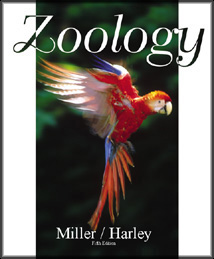 |  Zoology, 5/e Stephen A. Miller,
College of the Ozarks
John B. Harley,
Eastern Kentucky University
Circulation, Immunity, and Gas Exchange
Zoology Lab CorrelationsExercise 20: Vertebrate Circulation
Exercise 20 begins by having students study blood smears and components of blood. It continues with a study of the circulation of a shark. The study of mammalian circulation begins with the mammalian heart. The primary student dissection involves the circulatory system of the rat. A study of heart models helps students understand evolutionary changes in vertebrate circulatory systems. The exercise concludes with exercises demonstrating electrocardiograms and antibody action.
Exercise 21: Vertebrate Respiration
This exercise offers an opportunity for the student to study gas exchange organs of a fish (the shark) and a mammal (the rat). Shark gill structure is examined in a demonstration dissection, and lung structure and function are observed in a slide study and rat dissection.
|
|



 2002 McGraw-Hill Higher Education
2002 McGraw-Hill Higher Education